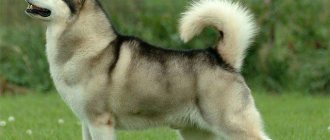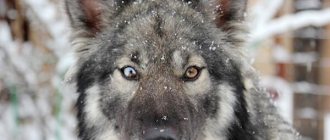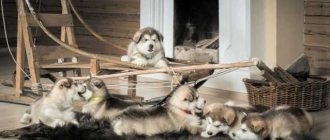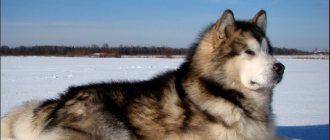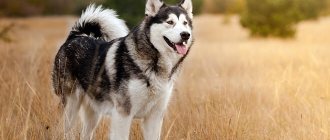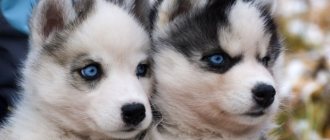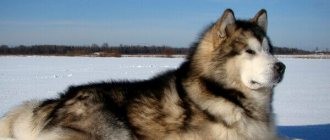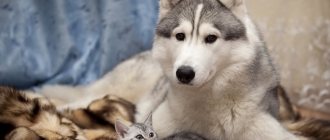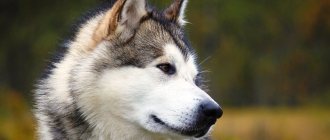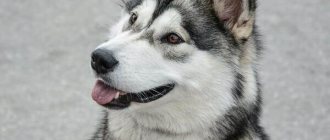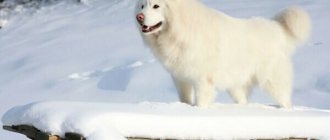Malamutes are large, muscular dogs with dense, thick fur and powerful paws that look like snowshoes. They were bred to do hard work. And behind their spectacular appearance lies a difficult character, which only an experienced and determined person can cope with.
When thinking about buying a puppy, you need to take this moment into account and find out everything about Malamutes in advance.
Brief history of origin
Malamutes are considered one of the oldest dogs on the planet. It is assumed that they have lived alongside humans since the Paleolithic era. This theory is confirmed by the remains of similar dogs found during archaeological excavations. Interestingly, they have a lot in common with modern representatives of the breed.
In 2004, geneticists conducted a DNA study, the results of which suggest that Malamutes are similar to wolves, Klee Kais and huskies.
Dogs arrived in North America about 14 thousand years ago. They wandered for a long time along with the ancient Eskimos, guarding human habitation and helping to hunt. The need to survive in harsh climates and with limited food made the dogs much stronger and more resilient.
Over the course of several centuries, the formation of the breed took place near the Anvik River, where the Malemute tribe, which migrated to Alaska from Siberia, settled. The ancient Eskimos had their own idea of what dogs should be like. Representatives of the tribe valued animals not for external attractiveness, but for strength, resistance to frost, hunting qualities and the ability to transport heavy loads.
Malamutes appeared in Europe only in the second half of the 19th century.
The subsequent popularization of the breed was facilitated by the “gold rush”, thanks to which in 1896 everyone dreaming of wealth began to gather in the Klondike. Since it was very difficult to move through the snowy northern expanses, people felt an urgent need for Malamutes. Because of this, the price of sled dogs instantly jumped up. For one Malamute you had to pay 500 dollars, and the team cost 1500.
To avoid paying so much money, gold miners began to bring St. Bernards and Newfoundlands with them and tried to mate them with local dogs. But the puppies from such matings had a beautiful appearance and a quarrelsome, aggressive disposition. In addition, in terms of strength and endurance, they were inferior to Malamutes and were not suitable for riding work. Therefore, the experiments had to be stopped.
To improve the speed characteristics of the breed and its ability to adapt to different climates, Malamutes began to be crossed with small dogs. Because of this, sled dogs are in serious danger of extinction. The disaster was averted only thanks to the efforts of enthusiastic breeders who managed to restore the breed. Over the next two decades, the breed was divided into 3 varieties - Kotzebue, M'Loot and Hinvan-Irwin.
With the outbreak of World War II, the Malamute population began to rapidly decline, and by 1947 there were only 30 registered dogs in the population. To restore the breed, breeders had to deviate from generally accepted standards.
Today, the Malamute is considered one of the most popular dogs and is officially recognized as the symbol of Alaska.
What should a dog owner do when she begins her sexual cycle?
During a walk, you must carefully monitor your pet, do not let go of the leash, and do not allow dogs to approach it. In pharmacies or pet stores they buy a product that eliminates the odor that attracts males. It is applied to the back of the body before going outside. There is no point in constantly giving contraceptives if pregnancy is not planned. It is better to sterilize the animal.
If the owners want puppies, you can start with a male. It is important to choose the right male. It is better to knit on his territory.
During this period, the dog is at risk. That is, dogs sometimes develop pathologies. For example, uterine prolapse. There is a high predisposition in bulldogs and boxers. This occurs due to hormonal imbalances. Estrogens cause thickening of the walls of organs, which leads to disruption of the muscle tone of the womb and the position of the uterus.
There are many diseases, and their development does not always depend on the conditions of detention and care of the owner. Due to the effects of hormones, the dog's behavior changes significantly, sometimes it becomes lethargic and inactive. If there are other symptoms, you should show her to a doctor.
Particular attention should be paid to discharge. It is important to take into account their consistency, smell, quantity, shade. The fluid usually looks like thick blood at first. Then it changes, becoming paler and more slimy.
If the discharge gives off an unpleasant, putrid odor, you should take your dog to the veterinarian. Black, green or yellow color is also considered pathology. Excessive fluid can also be a negative symptom.
When emptying, the pet spends a lot of energy preparing for fertilization. Therefore, the immune system is noticeably weakened. During this period, it is easy to get an infection under the following circumstances:
- walking;
- interaction with other dogs;
- bathing;
- being in the grass.
If the pathology strengthens, this leads to complications in this cycle and deterioration of health. Pyometra is considered a dangerous disease. It is characterized by fever, decreased activity and appetite.
Video: A dog is in heat: how long does it last and how often does it happen?
Interesting Facts
Throughout the history of the existence of Malamute dogs, a lot of interesting things have happened to them:
- These dogs specialize in transporting heavy loads. In a harness they are able to drag a load weighing up to 1500 kg.
- In 1984, the American Postal Service issued AKC stamps featuring four purebred dogs, including Malamutes.
- Dogs of this breed hardly bark. Alaskan Malamutes make wolf-like howls.
- Representatives of the breed often appear on movie screens. Malamutes starred in such films as “The Last Trapper”, “Iron Will” and “White Captivity”.
Breed characteristics
The calling card of the “Alaskan” is his large frame, muscular body and hardy body. Outwardly, the dog resembles a wolf. There is an opinion that the oldest breed of dogs originated from wild animals. And thanks to this relationship, the Alaskan Malamute himself got the opportunity to act in various films, playing the role of a wild fellow visually similar to him. Although in fact these dogs are excellent companions and family men who cannot imagine life without their owner and his children.
Weight. Standard body weight depends on the gender of the animal. Males weigh about 38 kg, while females are smaller: their standard weight is only 34 kg.
Height. The height of the females is 58.5 cm. The height at the withers of males is 63.5 cm.
Color. The color of the coat depends on the intrabreed line. In the Kotzebue line, only gray color is found, which is popularly called wolf color. But in the M'Lut line there are such colors as blue, black and white, brown and white, sable, even white and red. According to the standard, solid colored Malamutes can only be white.
Lifespan. The Alaskan Malamute lives from 12 to 15 years and is considered one of the longest-living four-legged friends.
Character. There are pets about which they say: “This is a dog of one person.” Malamutes are the complete opposite. They feel most comfortable only in a family - both canine and human.
They cannot be left alone; you need to play with them endlessly, or at least give them passive attention: hug, caress, talk.
Intelligence. Alaskans are very smart, but also incredibly stubborn
If the dog stops following your commands, know that he is simply tired of doing what you ask. It is enough to give your pet a rest - and he will again begin to understand you perfectly.
Security and guard potential. The breed is not at all created for protection. These are sled, “working” dogs, so their genes contain a potential different from that of a guard dog.
The first heat of an Alaskan Malamute girl begins between eight months and a year, and repeats every six months. The maximum duration of the process is 20 days. The starting age for mating is considered to be two years - the period when the dog becomes fully sexually mature. Dogs are bred on the 12-15th day of the bitch's heat. Pregnancy lasts from 56 to 72 days, depending on the number of future offspring: the more puppies, the shorter the gestation period. Movements of the offspring become noticeable around the 50th day. On the eve of birth, babies freeze in the mother's womb.
Alaskan Malamutes are more likely than others to end up on the abandonment list. An inexperienced owner, who has bought into the plush appearance of the puppy, subsequently cannot cope with his stubborn character and abandons the pet due to his own inadequacy as a teacher and dog breeder.
External standard
A dog of this breed is always judged on one main criterion: whether a member of the breed can be considered an Arctic sled dog or not. Existing defects are assessed in a similar plane: the more they affect the basic function of the animal, the worse. Based on the table, you can independently evaluate an adult individual for compliance with the breed standard.
Table - Features of visual standardization
| Part of the body | Characteristics |
| Head | — Wide; - volumetric; - proportional; - face with a friendly expression |
| Nose | — Black; - red in dogs of the corresponding color; - let's say "snow nose" |
| Bite | Scissor-shaped (overshot and undershot - a disadvantage) |
| Eyes | — Almond-shaped; - standing obliquely; - dark, usually brown; (blue - disadvantage) |
| Ears | — Triangular; - slightly rounded at the tips (set high - a disadvantage) |
| Small of the back | — Strong; - proportional; - medium length (long is a disadvantage) |
| Tail | - Raised and slightly curled; - with a lush edge; - visually resembles a plume |
“Snow nose” is a feature of Alaskan Malamutes in which the nose is streaked with white, contrasting with the base color.
Breed description, standards, appearance
The Alaskan Malamute is a powerful, proportionally built, compact dog with strong bones and developed muscles. The first breed standard was approved in 1935 and was adjusted several times. Today, a dog’s appearance is assessed according to the 1999 edition of the document.
According to him, a malamute looks like this:
- The head is wide, proportional, with a rounded skull, large muzzle, flat cheekbones and a prominent stop. The jaws are powerful, with a full set of strong teeth that meet in a scissor bite. The lips are thin and tightly fitting. The nose is large, with wide nostrils and a black nose. A red Alaskan Malamute may have a brown nose.
- The eyes are medium-sized, almond-shaped, slanted. The iris is brown.
- The ears are medium-sized, erect, triangular, with rounded tips. When alert, turned to the sides. In the process of work they are laid back.
- The body is compact, with strong bones, a strong, moderately arched neck, deep chest and developed loin.
- The limbs are massive and muscular. Paws with thick pads and curved, tightly closed toes. The interdigital space is abundantly overgrown with hair.
- The tail is a continuation of the top line, rises above the back without touching it and curls into a ring.
The breed standard also contains a list of defects, the presence of which will disqualify the dog. This list included:
- Blue eyes;
- not black color of the nose;
- polydactyly;
- cryptorchidism.
Size and constitution
The Alaskan Malamute dog breed belongs to the large category. Its representatives have a strong skeleton and moderate sexual dimorphism.
| Weight, kg | Height, cm | |
| Female | 30-34 | 58-62 |
| Male | 33-38 | 62-66 |
Color and coat type
The Alaskan Malamute has a double coat, which consists of a hard outer coat and a soft, dense down. The length of the spine differs in different parts of the dog’s body. The neck, shoulders, croup, tail and hips of the Malamute are covered with longer hair. Short fur grows on the dog's head, face and paws.
The Alaskan Malamute standard provides for a coat color, which eliminates the presence of unevenly spaced spots. It allows for the existence of several color options:
- solid white;
- black and white;
- gray with white;
- sable with white;
- silver with white;
- red with white;
- blue with white.
On a note. A poorly defined cream mask is acceptable on the face of a white Malamute.
Health and life expectancy
Alaskan Malamutes, like other large breeds, are not long-lived. On average, these dogs live 10-12 years.
Since the formation of the breed occurred under the influence of strict natural selection, Alaskan Malamutes have good health and good heredity. But they also get sick sometimes.
The breed has a predisposition to the following pathologies:
- hip dysplasia;
- adenocarcinoma of the anus;
- atopic dermatitis;
- retinal atrophy;
- polyneuropathy;
- hemophilia;
- hypothyroidism;
- demodicosis;
- cataract;
- glaucoma;
- diabetes.
Mating
If the owner is going to breed his pet, he needs to carefully monitor each heat. Record its beginning, duration and record all changes in the dog’s behavior. For each bitch, the peak of sexual activity is individual. On average, it occurs 10–16 days after the onset of estrus. During this period it is worth doing knitting.
When mating, the female must come to the male, and not vice versa. The room where this process will take place should not be noisy or crowded. Over time, dogs must succumb to their instincts and understand for themselves what is required of them. Otherwise, specialist help may be required.
Character and behavior
Alaskan Malamutes are good-natured and sociable dogs. They do not show aggression towards strangers and are not suitable for the role of guards.
Energetic and sociable dogs have a complex character and are prone to dominance. Malamutes perceive their owner's family as a pack and may try to compete for leadership. And if they are not immediately shown who is boss, then problems will not be avoided in the future.
Stubborn Alaskan Malamutes do not tolerate rudeness and remember insults for a long time. If given the right opportunity, dogs will definitely take revenge.
Breed and other animals
Due to their tendency to dominate, Alaskan Malamutes do not get along well with dogs of the same sex, but get along well with members of the opposite sex. They also hardly tolerate the presence of small rodents and cats.
Breed and children
Despite their natural good nature, the Alaskan Malamute is not the best choice for families with young children. An energetic and heavy dog can inadvertently frighten or injure the baby. But for teenagers, the Malamute will be an excellent friend and playmate.
First heat
The first heat can occur at different times. It all depends on the breed and individual factors. As a rule, in small breed dogs (such as dachshunds, Pomeranians), the first signs of estrus begin already at 7–8 months. For bitches of medium breeds (pug, cocker spaniel) - at 8-14 months, and for large breeds (shepherd, mastiff) - at 13-15 months.
To plan mating, you should not rely on the first heat . As a rule, the duration of estrus in dogs at this time is not constant; it can begin earlier or later, be interrupted, and even be invisible to the average owner. In order not to risk causing a false pregnancy, it is better to wait with mating until the third heat, when the female’s body has fully adapted.
The onset of estrus is caused by bloody discharge. To find out the exact time of onset, it is best to contact your veterinarian. He will be able to carefully examine the dog and, taking into account the characteristics of the breed and your bitch, will give a more accurate answer.
How to choose a pet
When buying a dog from someone else, there is always a risk of becoming the owner of a sick or non-purebred animal. To avoid such surprises, it is advisable to purchase Alaskan Malamute puppies from registered nurseries or from trusted breeders who value their reputation. When choosing, you need to pay attention:
- for the presence of documents and stamps;
- the conditions in which children are kept;
- behavioral characteristics;
- health status.
Important! The number of the brand on the puppy's belly or ear must match what is written in the birth certificate.
An important role in choosing a puppy is played by its appearance. It must comply as closely as possible with the current standard and be free from serious defects. Pedigree Malamute puppies have:
- dark eyes;
- smooth, thick paws;
- fluffy wool;
- thick tail;
- standard color.
How to determine the onset of heat
- Even obedient individuals cease to obey the owner.
- The first time the discharge is scanty. If the puppy is clean, it may not be noticed. If you suspect it, you need to blot the loop with a napkin daily to check for any discharge.
- The bitch may have digestive problems.
- The loop greatly increases in volume, and when pressed, bloody discharge appears.
- Well-mannered dogs can begin to relieve themselves at home.
- The bitch becomes lethargic and sleeps a lot.
- He flirts with male dogs, but doesn't let them get close.
Puppy care
A Malamute puppy leaves the breeder fully adapted to independent living. Therefore, he is simply allowed to explore new possessions and shown where his bowls and bed are located. And to make it easier for the baby to bear the separation from his mother, some thing with the smell of his native “nest” is placed in his place.
Important! To prevent the curious Malamute puppy from being injured, all wires, poisonous plants, medicines and household chemicals are removed from the house even before his arrival. And so that the little mischief does not spoil anything, valuable and fragile objects are hidden from him.
So that you can safely walk with an Alaskan Malamute puppy, it is subjected to preventive vaccination. This will protect it:
- from parainfluenza;
- leptospirosis;
- plague;
- rabies;
- parvo and coronavirus enteritis.
The first vaccination is given to the puppy at 8-9 weeks and repeated after 21 days. Before vaccination, he is given anthelmintic drugs, the dosage of which is calculated exactly according to the pet’s weight.
Antihelminthic treatment is carried out twice with an interval of 10-14 days.
Hygiene and care
During estrus, the dog owner must follow some simple rules. To begin with, it is best to note when the heat began and ended. This is necessary to approximately know the beginning of the next estrus and the periods most favorable for mating.
If mating with a male is undesirable, you should not let the female off the leash during estrus. Even with a good knowledge of commands, the bitch’s behavior changes, and she may behave completely differently than expected. It is worth carefully ensuring that the male does not come too close, since in the event of mating it will not be easy to pull him away.
During estrus, the dog should be restricted from exhibitions and competitions. The character of a bitch changes greatly, and it is impossible to predict her behavior. In addition, the risk of unplanned mating increases. Also, you should not allow your pet to go to bodies of water or other places where she can easily catch an infection.
In addition, special underpants . Whether the dog wears them or not is up to the owner to decide. Veterinarians advise against using them, since the bitch must lick herself during this period. But if spotting causes severe discomfort, you should use it.
When choosing panties, you should know a few simple rules. Panties must be made of natural fabric, with a special hole for the tail. They should be sewn without seams so as not to irritate the pet. The size must be completely appropriate for the dog so that they do not cause discomfort. Various options are available with Velcro, fasteners, etc.
Care and maintenance
The Alaskan Malamute is more accustomed to Spartan conditions. The dog is uncomfortable in the apartment, but on the street he feels in his element. True, the Alaskan Malamute has a habit of digging, so it should not be allowed out of the enclosure unattended. Otherwise, a large and energetic dog will turn the owner’s flowerbed into a huge hole in a matter of minutes.
Important! When kept in an apartment, the Alaskan Malamute sheds all year round, and due to the heating being on, the dog suffers from overheating and dermatological diseases.
Hygiene procedures
The Alaskan Malamute does not require complex and time-consuming grooming. For a dog to have a neat appearance, basic hygiene is enough:
- The pet's ears are cleaned 2-3 times a week with a cotton swab dipped in a special product. They are also checked for heavy or foul-smelling discharge. If suspicious symptoms are detected, the dog is shown to the veterinarian.
- The eyes of the Alaskan Malamute are wiped daily with a cotton pad moistened with chamomile infusion. If increased dryness, redness, or excessive lacrimation is detected, the dog is scheduled for a consultation at the clinic.
- The Alaskan Malamute's nails usually wear down on their own. If necessary, they are shortened with a nail clipper.
- The Alaskan Malamute's teeth are brushed weekly with a silicone brush and a small amount of special toothpaste.
- The dog's fur is combed 3-4 times a week with a slicker brush or a wide-tooth comb. During the molting period, the procedure is carried out daily, and the usual tools are replaced with a furminator. The fur between the dog's toes is carefully trimmed as it grows. The Alaskan Malamute is bathed no more than 3-4 times a year. And after bathing procedures, the dog’s fur is thoroughly dried so that eczema does not form on the skin.
Feeding
The Alaskan Malamute needs a complete and well-balanced diet, enriched with animal proteins. It is advisable to feed him in a strictly designated place and on approximately the same schedule.
The routine should be drawn up depending on the age of the dog:
- younger than 8 weeks – 5-6 times a day;
- 2-6 months – 4 times a day;
- 6-12 months – 3 times a day;
- over 12 months – 2 times a day.
Industrial feed
This type of feeding is not typical for Alaskan Malamutes. But for their own reasons, many owners prefer to give their pets ready-made food. They are chosen depending on the dog’s age and level of physical activity. When purchasing industrial feed, it is important to look at the expiration dates and composition of the presented assortment.
High-quality super-premium drying should have a high protein content and a complete absence of soy, wheat, dyes and corn.
Alaskan Malamutes eagerly eat the following brands of food:
- Gemon;
- Bosch;
- Pronature;
- Arden Grange.
Natural feeding
With this type of nutrition, the diet of the Alaskan Malamute should be dominated by fresh meat, which is kept in the freezer for several days and scalded with boiling water. It can be beef, lamb, rabbit, turkey or chicken. But meat alone is not enough for a dog to receive all the nutrients. Therefore, the following is additionally introduced into the diet of the Alaskan Malamute:
- cereals;
- vegetables;
- offal;
- sea fish;
- chicken eggs;
- dairy products.
In order not to harm the dog, the following are completely excluded from its menu:
- onion;
- mushrooms;
- pork;
- chicken bones;
- confectionery;
- any food from the master's table.
Walking and exercise
Alaskan Malamutes are energetic sled dogs and require hours of exercise every day. Moreover, they will not be satisfied with sedate walking next to the owner. To maintain muscle tone, Alaskan Malamutes need full exercise in the form of jogging or cycling. If the Alaskan Malamute is deprived of the opportunity to splash out his energy, he begins to feel sad. To have fun, a dog can howl for a long time, make digs and damage property.
Important! The Alaskan Malamute is a large dog that can only be held by a physically strong person. Therefore, dog walking cannot be delegated to teenagers and fragile girls.
Training and education
Due to the innate stubbornness and tendency to dominate, you need to start training the Alaskan Malamute from the first days of his stay in the house. Until the puppy receives all vaccinations, he is trained at home. The first lessons should not last longer than 5-10 minutes. They are carried out in a calm atmosphere according to the principle “from simple to complex.”
After the end of quarantine, the Alaskan Malamute begins to be accustomed to the street. At first, they walk with him in quiet, secluded places. When the puppy stops being afraid, they begin to introduce him to busy streets and teach him to calmly deal with various irritants such as people, strange animals and transport.
By the age of six months, the Alaskan Malamute should:
- unconditionally run up at the first call;
- walk calmly on a leash;
- do not take food from the ground or from the hands of strangers;
- follow the commands “Sit!”, “Place!”, “Stand!” and “Lie down!”
Important! It is better to train an Alaskan Malamute under the guidance of a professional. After all, it is much easier to raise a puppy without bad habits than to later correct the mistakes of an inexperienced trainer.
Signs of heat
During estrus, a dog's behavior often changes dramatically. Estrus can be determined by the following signs:
- bloody discharge from the loop;
- unusual activity or aggressiveness for a dog;
- sadness;
- frequent urination;
- increased attention from male dogs;
- molt.
During estrus, large breed dogs may become more aggressive. If your pet has stopped obeying normal commands and is overly excited, it is better to limit your movements around the city with him. Smaller breeds are characterized by excessive activity and playfulness.
When walking with a female dog in heat, you should be on guard. The smell of the discharge attracts males, which often causes unwanted mating. To prevent unwanted consequences, you should protect your pet from other cables.
Pros and cons of the breed
Although the breed is popular among ordinary dog breeders, it has not only advantages, but also disadvantages. And it’s better to get acquainted with them before making a final decision on purchasing an Alaskan Malamute.
| pros | Minuses |
| Pretty appearance | Tendency to dominate |
| Friendly disposition | Unsuitability for apartment living |
| Endurance | Need for long walks |
Character of the Alaskan Malamute
The Alaskan Malamute is a dog that perceives everyone around him with his inherent friendliness. These northern beauties are very energetic and active from early childhood - only by the age of three they become a little calmer. These dogs require increased attention: you need to constantly play and run with them.
Outwardly similar to a wolf, the Alaskan is not at all adapted to hunting or protection. So leaving it in the house in the hope that it will protect property from thieves is frivolous. Rather, he will kindly and joyfully greet the insidious burglar, mistaking him for a friend. Alaskans cannot bark, but they sing excellently.
Malamute strives to dominate everywhere. And if you raise him incorrectly, then he is unlikely to be good-natured and sociable. The pet has an excellent memory
This fact is important to consider when raising children. He can remember any rudeness committed during training later, and then even take revenge for it.
It’s difficult to call this pet a monogamous person: if you offend him and lose his respect, he can immediately switch his interests to another person
The Malamute is used to living in a pack, so it is important for him to be surrounded by people or dogs. At the same time, the northern giant cannot be kept in a confined space or left alone for a long time.
It is not advisable to leave a dog with small children, because in its desire to control everyone, it may inadvertently harm the child. Good-natured towards people and dogs, Malamutes often show aggression towards other animals and birds. In order for the handsome Alaskan to accept the company of other pets, he needs to be introduced to them as early as possible.
Most likely, the Alaskan will dominate among the other favorites. This Arctic dog has a strong character and a great desire to be above everyone else.
Malamute price
The cost of an Alaskan Malamute puppy depends on the availability of documents, exhibition prospects, the eminence of the ancestors and the reputation of the kennel.
- A dog without a pedigree costs between 5-10 thousand rubles.
- A puppy with documents, but without any relationship with the champions, is estimated at 20-40 thousand rubles.
- An Alaskan Malamute from titled parents with the prospect of a show career costs 70-120 thousand rubles.
Alaskan Malamutes are large, showy dogs with a friendly but stubborn personality. Hardy and strong dogs will become faithful companions to those who are willing to spend time on long walks together.
External differences
Husky originated in Siberia, its ancestors were local northern dogs that were used by the Chukchi for sledding. The breed was registered in 1930.
Malamutes, whose ancestors were wolves, were bred by the Eskimos of Alaska. These dogs became so popular that in 2010 they were made the state symbol of Alaska.
Both breeds were intended for traveling in sleds; they had to be able to overcome a long distance across snowy expanses.
Huskies are very agile, they are able to quickly run long distances, but due to their relatively light weight they cannot carry heavy loads. Malamutes are large, strong dogs that can walk many kilometers with heavily loaded sleds. But malamutes lack the irrepressible energy of huskies and will overcome their path slowly and sedately. The different capabilities of working with a team were reflected in their appearance, weight and size.
Despite some similarities, both breeds have many differences. Dogs have completely different ancestors.
It is not surprising that the appearance and character of these animals can differ even with the same tasks assigned to them
. Let's consider how to distinguish representatives of these species from each other.
- Visually, you can immediately understand that the Malamute is larger: it is about 10 cm taller than a representative of another breed and 10 kg heavier. But a husky can eat a lot and gain extra pounds; overeating has not been observed in a malamute.
- Dogs work in harness in different ways; their working potential can be assessed by their appearance. At first glance, you can see the strength and power of the Malamute, strong stocky bones, developed muscles, strong legs. Gives the impression of a handsome athlete with his head held high. He has a lot of energy, without getting tired, he transports heavy loads over long distances. But speed is not his strong point; it belongs to the husky’s advantages. The average size of dogs of this breed, their mobility and lightness allows them to develop enormous speed in a harness. They cover long distances, but are not capable of carrying very heavy loads.
- The coat of both breeds is quite warm, the dogs do not freeze even in the most severe frosts, but the difference in fur can be seen visually and tactilely. The Malamute's awned hair is coarse, hard, and sticks out to the sides. The color of the fur coat can be from light gray to black, from beige to brown, but the fur on the belly remains white. Husky fur is close to the body, the undercoat is very soft, and the awning hair is also not particularly hard. The wool of the Siberian breed is more pleasant to the touch. Any color from white to dark is allowed.
- The Malamute's head is proportional to the body, large, and firmly set. In a husky it is smaller, more graceful, and the muzzle is more elongated. Outwardly, the Malamute looks very good-natured, which corresponds to his character. A husky can look different, sometimes the pattern of the mask and the cold shade of blue irises framed by a black line around the eyes make the expression of the muzzle angry and angry. But this is a misleading impression. Hidden under the mask is a kind, loving, playful animal.
- Malamute, according to the standard, must have brown eyes; blue eyes are rare and are considered a defect. Husky can have any shade, but blue is considered more advantageous.
- Alaskans' triangular, high-set ears are rounded, while Siberians' ears stick out with the corners up.
- The tails of both dogs are fluffy, raised up with a slight bend. The Malamute has longer hair on its tail, and when standing it is carried over its back. A husky's tail drops when it stands.
In our nursery (Perro del Norte), births take place at home and we deliver them ourselves. The bitch will be calmer if there are people close to her, and not veterinarians from the veterinary clinic. However, it would be a good idea to have contacts of a good clinic in case of complications, where you can promptly take the dog. Of course, this procedure is not easy; it requires not only perfect knowledge of childbirth, but also strong nerves. Don’t forget also that a bitch usually gives birth at night; the intervals between contractions for our dog lasted from half an hour to 3 hours, so we were ready to stay up all night. On average, Malamutes give birth to 6-8 puppies, but this is not a pattern, we know cases of 11 and 2 puppies. So, how it all began. Firstly, you need to understand that pregnancy in Malamutes lasts 60-65 days. This time is enough to prepare everything you need.
You need to start by choosing the place where the puppies will be delivered. In our case, this is a corner in the kitchen where we install the box. The box will serve as a place where the puppies will live for the first month, so the height of the sides should be low enough for the bitch to move in and out of it freely and high enough so that the puppies cannot climb out of it. Our sides are approximately 30 cm high.
The box in this photo is used for the second birth, so the teeth marks are clearly visible. On the inner walls, about 10 cm from the bottom, I fixed a 5x5 cm block. If the puppy is lying against the wall and the mother inadvertently pressed him, he will have enough oxygen so as not to suffocate.
It is better to introduce the dog in advance to the place of future birth. You can put her bedding there, her favorite toy, or just sit with her a few times. Starting from day 57, we measure the dog’s body temperature and, as soon as it drops by 1-2 degrees, that is, until 36-37, we understand that day X has arrived. The dog begins to noticeably get nervous and rush around the corners. In addition to the box, we prepare an ordinary box, on the bottom of which we put 2 warm heating pads and a towel. This is the place where we transfer newborn puppies from the mother during labor and birth of the next ones. We sterilize the scissors with blunt ends that we use to cut the umbilical cord. We steam a lot of rags/towels to dry newborns.
The photo shows the first minutes of a Malamute puppy's life
Some puppies may be born with no signs of life or almost motionless. In this case, as quickly as possible, we clear his airways of mucus and rub him with a towel. As soon as the newborn squeaks, we apply it to the mother’s nipple and make sure that a characteristic smacking sound is made. It would be a good idea to let the mother lick the puppy. Immediately after the puppy has had enough of its mother's milk, we tie a colored ribbon on it, weigh it and record the time of birth.
If the bitch is a responsible mother, then she will not be away from the puppies for long, especially in the first days after giving birth. The dog may even refuse to eat and walk, as was the case in our case, so it is very important to help her with this. While the dog is walking, we change or adjust the sheets in the box and cuddle with the newborns. Until she feeds herself, the bitch will lick the waste products of the puppies, so you don’t have to worry about this for 2-3 weeks after birth. At 10-12 days, newborns' eyes open, and at 3-4 weeks teeth erupt. It is at this moment that all the mother’s care begins to disappear very quickly. The sharp teeth of puppies cause severe discomfort to the mother when sucking. But there’s nothing you can do about it, besides, from now on we begin to gradually feed the puppies with soaked dry food.
If the mother has enough milk, the puppies gain weight very quickly and develop well. They are very active and frolic with each other. As soon as the puppies start feeding on their own, the mother will regurgitate half-digested food for them. The main thing here is that the bitch does not go hungry; we had cases when Ray vomited food for the puppies 4-5 hours after feeding. We had to feed her again and separate her from the puppies for quite a long time.
From 45 to 60 days after birth, we call an experienced dog handler to activate the puppies. The specialist evaluates how well each puppy meets the breed standard and places a mark (tattoo) on the inside of the ear or groin. Failure to meet the breed standard does not mean that the puppy is bad or “rejected”; it means that it is not recommended for breeding and becomes a pet. Puppies that meet the standard are intended for exhibition and breeding. It is difficult for an inexperienced person to discern these inconsistencies, but this is not necessary if you are looking for a puppy for home, as a pet. Choose the puppy that resonates with you and you won’t regret it. Malamutes are very affectionate dogs, they love children and their pack, that is, you. Having become part of this pack once, you will forever link your fate with the most devoted and loving dogs.
View this post on Instagram
Children have breakfast
